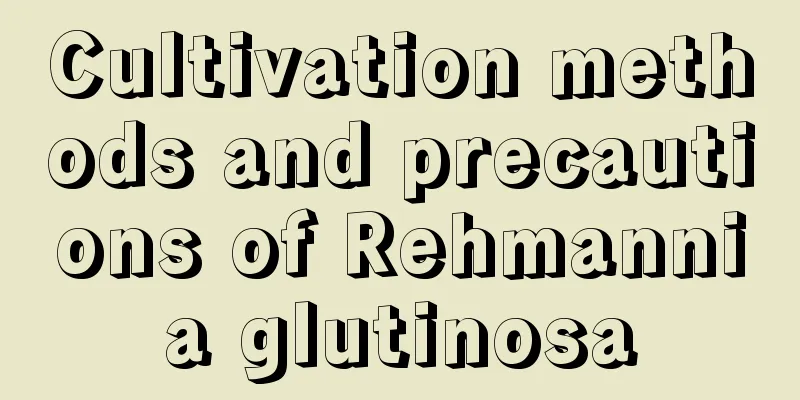Cultivation methods and precautions of Rehmannia glutinosa

1. Maintenance methods1. Soil: Rehmannia likes fertile soil. It is not suitable for sticky red soil and yellow soil. Generally, sandy soil is the most suitable for planting. 2. Water: Rehmannia has poor water absorption and a small root system. Too much water will cause its rhizomes to rot. Just keep the soil moist and water less frequently. There should be no accumulation of water. When it rains, drainage should be carried out in time to prevent flooding. 3. Nutrients: After planting, Rehmannia needs to be fertilized once. Generally, chicken, duck, pig manure and human manure can be used. For the rest of the time, you only need to apply fertilizer once every half a month, which is more conducive to the growth of Rehmannia. 4. Sunlight: Rehmannia is a plant that likes light and needs a good sunshine environment during its growing period. When choosing land for planting, do not choose a place close to tall crops, as they will block the sunlight of the place. But it is also not resistant to strong light, which is something you need to pay attention to. 2. Breeding techniques1. Weeding and pruning: As the Rehmannia grows, some weeds will grow in the soil. At this time, the weeds need to be dealt with in time, otherwise the weeds will absorb the nutrients in the soil. If the nutrients absorbed by the Rehmannia are insufficient, its growth rate will be affected. It is also necessary to trim off the dead branches and rotten leaves of Rehmannia in time to reduce nutrient loss. 2. Reproduction: Rehmannia is generally propagated by rhizomes. Choose strong rhizomes, dig them up and break them into short sections of 4 to 5 cm. After drying slightly, transplant it to soil with sufficient nutrients. Pay attention to drainage when it rains and wait until spring to transplant it. 3. Problem diagnosis and treatment1. Leaf spot disease: Leaf spot disease and wilt disease are common diseases after planting Rehmannia. At this time, you only need to use a double-volume Bordeaux liquid spray and pay attention to ventilation. 2. Pests: Cotton red spiders and butterflies are common after planting. At this time, you need to spray with carbofuran and dichlorodiphenyltrichloroethane. IV. Other issues1. How to survive the winter: In winter, if it is a potted plant, it needs to be moved indoors, and the temperature must be controlled to prevent frostbite. 2. Can it be placed indoors: It can be grown indoors, but considering the number of flowers blooming, we need to increase the sunlight appropriately, so that its flowers can bloom more brightly. |
<<: Daniel's breeding methods and precautions
>>: Breeding methods and precautions of Emperor Jade
Recommend
Mint and mugwort, repelling insects and benefiting the body and mind
Vanilla scent repels mosquitoes but attracts butt...
The flower language and cultural significance of firecracker flower
The flower language of firecracker flower The flo...
When is the best time to divide orchids and how to divide them
1. When is the best time to divide orchids? It is...
What fertilizer to add to the banyan tree soil
1. What fertilizer to add When changing the soil ...
Why are flowers fragrant?
1. The reason for the fragrance of flowers Some f...
How to grow lucky bamboo more vigorously in summer?
Lucky bamboo has become a favorite plant in many ...
When is the best time to plant ground grass seeds?
Ground grass seed planting time Floor grass is a ...
How to spend the winter with roses
1. Keep warm and protect against cold Although ro...
What trees are easy to grow and look good? What trees are best to grow indoors?
Money Tree Some people may think that the name of...
How to care for Xiuyan succulent
How to maintain The flowering period of Xiu Yan i...
How to take care of newly bought peonies
1. Temperature Peony flowers prefer shade and hat...
The difference between white orchid and yellow orchid
1. Difference of blades The leaves of the white o...
Winter Spinach Planting Time and Method Planting and Management Methods
Winter Spinach Planting Time The planting time fo...
How to grow lilies, pictures of lilies
1. How to grow lilies Flower pot: To grow lilies,...
What to do if the leaves of Christmas cactus wilt
1. Watering in time Christmas cactus is not suita...









